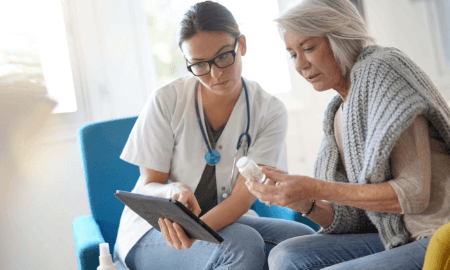Insights
How care-ready connectivity is transforming the NHS
Author
Mark Burton
UK Health & Social Care Lead
Virgin Media O2 Business
4 minutes
06th February 2024
Share this article:
There used to be a belief that everyone wants to travel to their local health centre and meet their GP face to face.
I don’t know about you, but taking a chunk of time out of my day to sit in a waiting room full of coughing, spluttering people isn’t always appealing.
Enter digital healthcare, which has been massively fast-tracked by the pandemic.
There’s been a big shift in the last few years to remote appointments. It’s the patient care of the future, but it’s important to remember it’s here to complement hands-on care, not replace it.
Improving efficiency with technology
In order to improve healthcare and social care outcomes, NHS organisations are challenged with improving IT infrastructure and transforming technology while enhancing productivity, efficiency and value for money for taxpayers.
It’s a balancing act between tight budgets, technology challenges and ambitious targets.
One of the success measures used by the NHS is Hospital Length of Stay (LoS). In the past reducing LoS was seen as the panacea to cost savings. The reality is the beds are never empty, so the cost pressure is ever present.
Digital healthcare however can improve the connectivity with patients beyond the hospital and facilitate on-time discharge of patients, reducing the 'bed blocking' curse of all hospitals. Digital healthcare actually makes the system more efficient which improves patient care and results in better value to the taxpayer.
Care-ready connectivity is key
Our approach to working with the NHS is to help improve efficiency, patient care and outcomes.
We’re not just looking at historical hospital infrastructure – we’re looking at providing access to care from a primary, secondary and social perspective.
To support the health sector as a whole, the NHS needs care-ready connectivity across the whole ecosystem. Connectivity that’s ready for anything, whether it’s a tough night shift, an emergency call-out or a busy day of frontline care.
Virgin Media O2 Business is well placed to help with that, but there’s much more to it. We’re all about working in partnership with NHS organisations, not just providing technology. We look to add value to the services we provide.
Boosting digital inclusion
There are many digital care pathways, for example diabetic care and hypertension care. These will make a big difference to preventative care in the future. Using digital technology to improve care before people get ill will save the NHS millions of pounds.
These are great initiatives to support care outside hospital, but people need to know how to use them. If staff or patients don’t understand the tech, it won’t be used.
We need a holistic approach to providing digital education and support for new tech or apps, so that we have a truly digitally inclusive healthcare system.
Over the last year we’ve been working closely with NHS organisations to ensure people are educated on the systems that are in place. We’ve got over 2,000 employees, each with five volunteer days per year, so I’ve been encouraging as many as possible to help in the health sector.
We’ve been spending time in medical centres and GP surgeries as part of our Connect More Digital Skills Programme. It’s been so rewarding helping patients access the NHS app on their phones and use it for new prescriptions and booking appointments. This helps reduce the strain on the primary care sector too.
Digital transformation in practice
We’ve also been setting up digital hubs to provide training to NHS staff.
For example, I’ve recently been working with the Pennine Care NHS Foundation Trust. We ran a digital maturity assessment and discovered existing technology was outdated. This was underpinned by poor digital skills amongst staff and inconsistencies in how clinicians used tools and software. Not only could this be detrimental to patients, but it also had a negative impact on staff productivity and wellbeing.
With our support, the trust embarked on a new digital strategy to address these issues. It replaced legacy technology, delivering cloud-based SD-WAN (software-defined wide area network) infrastructure and the latest cybersecurity solutions. It also created new digital hubs to improve skills for patients and the workforce.
Better connectivity, smarter processes and digital education has created very real and positive outcomes:
- Improved application performance with more insight and control
- Seamless recording and sharing of patient information
- More time spent on patient care
- Improved job satisfaction and cyber skills for clinicians
Digital transformation has improved the working environment for their clinical staff and provided more positive outcomes for patients. It’s been a brilliant project to be part of.
“I can’t put a price on how much these solutions are transforming our Trust, from both my security team’s perspective, and the clinicians and patients. They don’t know just how much protection they’ve been given.”
Pennine Care NHS Foundation Trust’s Chief Technology Officer, Mike Culshaw
Let’s address the here and now
Tech organisations can be guilty of looking too far into the future. We need to get the basics right first.
There are some big challenges out there – basic connectivity challenges. And all NHS organisations are at different stages of their digital transformation journeys.
Secure, integrated, care-ready connectivity is key to the future of digital healthcare, so it’s imperative to get it right. If you work in healthcare, get in touch and let’s have a chat about how we can help with your digital transformation.
0800 064 3790


